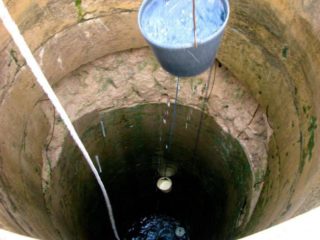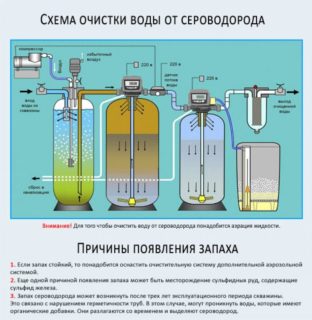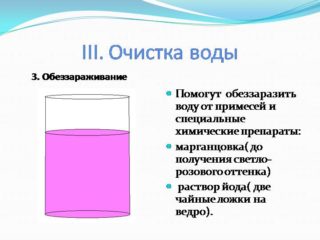A well is used as an autonomous source of water supply in a suburban area. Its performance allows the resource to be constantly updated in the mine. This, in turn, prevents the appearance of third-party odors in the water. But there are often cases when the owner of the site notices that the water has deteriorated in the well, an unpleasant smell emanates from it. You can deal with the problem on your own.
Reasons for bad odor from well water

The presence of third-party sharp amber from the well and its contents indicates that chemical or biological processes are taking place inside the mine. The causes of stench are:
- Decomposition of organic matter (algae) that got into the aquatic environment of the source. Often, such processes begin in those wells that have not been used for a long time (1-2 years or more). In this case, the water will smell like rotten eggs (hydrogen sulfide). The decomposition of organic substances and their use by anaerobic microorganisms provoke the appearance of hydrogen sulfide vapors. By itself, such a liquid does not pose a danger to humans. But it is impossible to drink it because of the nauseating smell.
- The presence of mechanical impurities. If garbage, chips, sticks regularly fall into the mine of a hydraulic structure, there is a supposedly rotting aspen shield at the bottom of the source, this can provoke the appearance of third-party odors. The water stinks of swamp or has stagnant amber. By eye, the presence of debris in the water is easy to determine. Such a liquid will be cloudy, dirty when taken.
- Overload with iron or other metals. Here, from the mine, the source will reek with iron. In appearance, the liquid has a yellow or brown color. If manganese contamination occurs, the aquatic environment will be black.
- Entering the horizon of chemical industrial effluents. In this case, the smell of oil products, rubber, and other chemicals comes from the well. The liquid in the source will foam.
You can determine the type and cause of contamination of the liquid in the source by its color and smell. But it will be useful to conduct a full analysis of the taken water.
Effective ways to fix the problem
Hydrogen sulfide
If the water seems to be rotten, it means that algae and other microorganisms grow in it that can live without oxygen. Why this is happening, there is no exact answer. Most likely, dense siltation occurs from the bottom. Either the productivity of the aquifer has decreased dramatically. Mine volumes are not being renewed as quickly as they used to.
Hydrogen sulfide is removed by primary mechanical cleaning of the walls of the mine from organic matter. To do this, you will have to completely pump out water from the hydraulic structure and treat the walls of reinforced concrete rings with a special disinfectant solution (chlorine, whiteness, tablets). The source is then completely filled and pumped out again.
Regardless of the reasons, the smell of hydrogen sulfide from water from a well can be eliminated by a physical method - aeration, that is, saturation of the liquid with oxygen. For this, non-pressure degassers are used, through which the liquid is forcibly driven.
The smell of the swamp

If the water in the well smells like a swamp, the reason for this is the silting of the filter bottom. To cope with the problem, you will have to completely pump out the liquid and replace the filter layers. To do this, you can lay zeolite, flint gravel, shungite in layers, 15 cm each. It will also be useful to treat the walls of the well with chlorine solution. It is applied to the entire surface of the rings from the inside and the source cover is closed for a day. Then everything is thoroughly brushed, washed off, and the remaining chlorinated water is pumped out. Within a week, the taste of the aquatic environment will change for the better.
Another way to disinfect liquid is iodine solution. It actively destroys pathogenic flora, prevents the multiplication of microorganisms in the aquatic environment.
To prepare a solution for 1 liter of liquid, you need to take 3 drops of iodine. As a rule, no more than 3-5 liters of solution is required for one RC ring. If there are 10 rings in a hydraulic structure, then you need to take 50 liters of water and 150 drops of iodine. The whole mixture is simply poured into the source and defended for a day. Then the well can be used for its intended purpose.
Water treated with iodine is not suitable for irrigation. Therefore, it is better to clean the resource in this way at the end of summer, in early autumn. The source will be completely renewed by spring.
Mechanical impurities
Chemical odors
If they are permanent, the well shaft should be deepened to another aquifer. Otherwise, wastewater from nearby industrial plants will still ooze into a home source. To make a deepening, you need to invite specialists who conduct preliminary drilling. It may turn out that the next layer will be very far away and a well will have to be drilled.
Preventing odors

So that the water resource of an autonomous source does not emit unpleasant odors, it is important to regularly carry out a number of preventive measures and observe certain principles when digging a well:
- Before work on the construction of a hydraulic structure, it is necessary to study the aquifer. This will help determine the quality of the water on the layer on which the digging will be carried out. In addition, thorough diagnostics insures against getting into clay layers and quicksands.
- When constructing a source, it is important to reach the waterproof layer. Otherwise, the well will silt regularly, which will lead to the appearance of third-party amber.
- When installing reinforced concrete rings, it is imperative to carry out high-quality sealing of the joints. Otherwise, water from the top water will ooze into the well.
- It is advisable to protect the top of the hydraulic structure from precipitation. If this is not done, atmospheric nitrates, acids and other harmful substances will be mixed into the well water.
- Well owners are required to regularly clean and disinfect the water. They do this at least once a year. Here it is recommended to inspect the filter bottom and change it if necessary. When cleaning and disinfecting the walls, it is better to work in pairs and use a respirator. Too great depth, lack of oxygen plus hydrogen sulfide vapors have a dangerous effect on the human body. The risk of losing consciousness is high.
Timely maintenance of the well, its correct operation insure against the appearance of third-party dangerous odors, which are many times more difficult to get rid of than to prevent.










